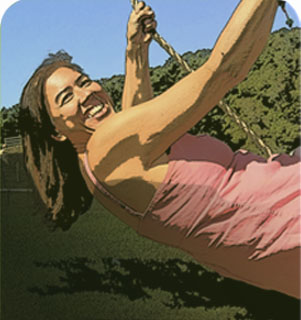A whole new canvas on life

May 22, 2012
Every person’s life is a blank canvas from which they must draw their own life, their own expression, their own way. What they see currently in their life is the canvas that they have created. What if you were to draw a whole new canvas? What would it would look like?
The first patient I ever treated in my practice, R., was an avid gardener with chronic and debilitating back and knee pain. The pain was becoming more and more intrusive, limiting her ability to do the gardening she loved. She was told that she had arthritis and probably would need a total knee replacement, and cortisone shots for her back with possible lumbar fusion.
In her first interview with me R. said, “gardening saves me, it keeps me from going insane with all the other things going on in my life”. She told me that she was working in a government job that paid the bills and gave her insurance and a feeling of security. I asked her about what she dreamed of and she said, “I always dreamed of being a landscape designer and a painter when I was young but never was allowed to take classes in either because my parents deemed it impractical. They were children of the depression and they worked hard to get me to college, I didn’t want to disappoint them”.
Of course her parents wanted to provide for her, to prevent her from suffering in the same way they had as children. They most likely wanted their daughter to have more materially then they had so that their future lineage would not suffer as they did. The problem for R. was not in her parents view point but what she created in herself. Namely, an internal unconscious belief that the only way to stay connected to her parents was through suffering, and to keep herself suffering because that is what she saw in her parents. She heard their concerns in her conscious mind, but internalized their anxieties and fears about hunger and deprivation. In so doing, she starved and deprived her body and mind from natural expression. It is not to say that painting and landscape design was the perfect job or the best fit for her, but she tightened herself every time she wanted to move toward creative expression and blamed job security for why she could not take a class or move forward in her life.
These insights did not come over night. We worked a lot initially with breathing techniques for relaxation, with craniosacral work to soothe her nervous system and release muscle tension, lymphatic work to take away some of the subacute inflammation around her knees and trunk, and Feldenkrais (movement awareness) so she could feel more comfortable in her own body. Whenever she would relax, she would go away and tighten up again.
“The truth is,” I said to her one day, “you took years to get here, it may take awhile to get to another place. Don’t expect that in having a blank canvas and a new way to look at life that the first canvas you draw will be a masterpiece. Monet drew many canvases and worked long and hard to create what he did”.
We explored different positions and movements that gave her the most pain and those that were relatively pain free (sometimes the only movement was blinking her eyes). She became aware of areas of constant tension in the body even at rest that never quite could be relaxed or retreat from her attention. I taught her energy anatomy, and how different areas of the body correspond to different chakras or energy centers, and that these centers relate to certain behavior and physical manifestations. We worked on different ways of movement, and bringing her attention to other parts of her body that needed attention. In doing all of this, we were able to create another relationship with her body.
She learned to cultivate a relationship of trust in her body where she could better listen to what her body was saying and to try something differently than the current pattern. Through working in this way, we were able to get to the (her) realization that her connection to her parents and in most of her closer relationships was through suffering. As she started to relax more, she became less afraid to see painful patterns of movement and thinking for what they were: ever changing and shifting. Most importantly, she became less attached to these patterns as a defining part of who she was. She still has pain on occasion in her knees and her low back, but no surgery. She has moved forward into her life with freedom and happiness, moving toward a beautiful canvas that only she could have painted.
